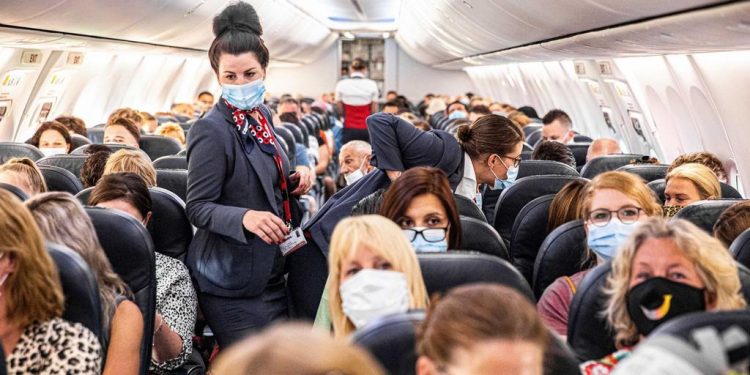New Delhi: Despite diagnostic testing of passengers before the departure of international flights, instances of in-flight transmission of the novel coronavirus are likely. This is according to a study that assessed people who travelled aboard a plane from Dubai to New Zealand. The study also said that longer the flight the more is the risk of contracting the novel coronavirus.
The research has been published in the journal ‘Emerging Infectious Diseases’. It assessed 86 passengers who travelled on a flight from Dubai, UAE and arrived in New Zealand September 29. The study said that seven who tested negative for the disease before boarding the flight tested positive on arrival.
In the study, the scientists, including those from the University of Otago in New Zealand, assessed information about the journeys of the passengers, their disease progression, and virus genomic data to determine the potential source of infection of these travellers.
According to the researchers, the passengers had begun their journeys from five different countries before a layover in Dubai. Pre-departure test results were negative for five of the travellers.
They said during the flight, and before departure in Dubai airport, mask use was not mandatory. Five passengers self-reported that they used masks and gloves while on the airplane. Two said they did not. The study noted that the seven passengers were seated within four rows of each. It took a little more than 18 hours to reach Auckland from Dubai. “None of the passengers reported having been in close contact at the Dubai airport,” the scientists wrote in the study. “Yet they picked up the virus on the flight.”
All 86 passengers on the flight underwent mandatory managed isolation and quarantine (MIQ) for 14 days. They went through diagnostic testing for the coronavirus on day three, and again on day 12 if the previous test result was negative, the study noted.
The scientists also determined the lineage of the viral genomes obtained from the seven passengers. According to the researchers, one of the passengers, who was the first among the seven to experience symptoms October 1 was ‘consistent with having been infectious while on flight’, and the second person to experience symptoms was this person’s travel companion.
They said the third individual to test positive was asymptomatic, while symptom onset and positive test result dates for three other passengers were ‘consistent with in-flight transmission’.
Based on the date of symptom onset, the researchers believe one of the seven passengers may have been infected during their stay with an infected passenger at the MIQ facility, where they resided in the same room.
“Evidence of in-flight transmission on a flight from the United Arab Emirates to New Zealand is strongly supported by the epidemiologic data, in-flight seating plan, symptom onset dates, and genomic data for this group of travelers who tested positive for SARS-CoV-2,” the scientists wrote in the study.
The researchers believe the findings present a likely scenario of SARS-CoV-2 transmission events during a long-haul flight. “These transmission events occurred despite reported in-flight use of masks and gloves,” they noted.
Citing the limitations of the study, the scientists said the data does not definitively exclude an alternative exposure event, ‘such as virus transmission at the Dubai airport before boarding’.
“However, the close proximity of the relevant passengers on board suggests that in-flight transmission is plausible,” they wrote in the study.
The study also noted that the environmental control system (ECS) of the flight, which provides air supply, thermal control, and cabin pressurisation for the crew and passengers was inoperative for nearly 30 minutes during its two-hour refuelling stop in Kuala Lumpur.
Even with pre-departure testing, social distancing, and personal protective equipment used in-flight, the scientists believe the findings underscore the importance of considering all international air travellers as being potentially infected with the coronavirus.






































